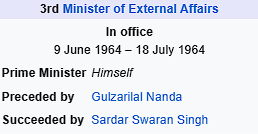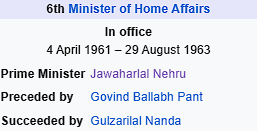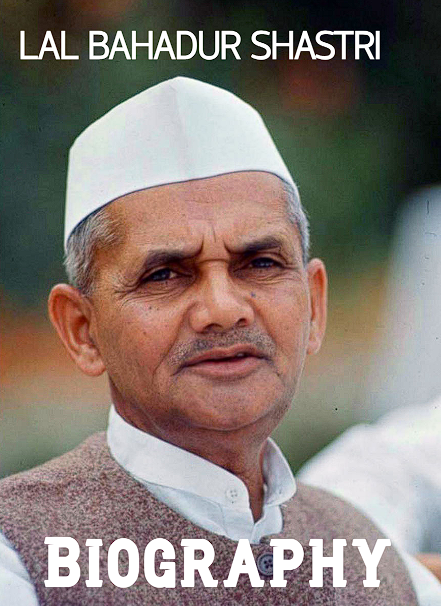Introduction
Lal Bahadur Shastri, born on October 2, 1904 in Mugalsarai, Uttar Pradesh, was a noted Indian leader and the country’s second Prime Minister. Known for his simplicity, honesty and dedication to public service, Shastri played a key role in India’s struggle for independence and later led the nation at crucial times, including the war against Pakistan in 1965. Influenced by Mahatma Gandhi’s principles, he emphasized hard work and self-reliance. His leadership and contributions to India’s progress are remembered with great respect and admiration. Lal Bahadur Shastri died on 11 January 1966 leaving behind a lasting legacy in Indian history.
Table of Contents
Lal Bahadur Shastri : Early Life and Education


Born on October 2, 1904 in Mughalsarai, Uttar Pradesh, Lal Bahadur Shastri faced early challenges when his father died when he was only one and a half years old. This unfortunate event resulted in financial problems for the family. Despite his adversity, his childhood was marked by the endearing nickname “Nanhe”, which was lovingly given to him due to his status as the youngest member of the family. These early experiences laid the foundation for Shastri’s resilience and determination and shaped his character for the challenges he would face later in his remarkable life.
Education and Struggles

After completing his primary education in Mirzapur, Lal Bahadur Shastri continued his quest for knowledge by moving to Varanasi for higher education. His dedication to education was evident in his daily routine of swimming across the mighty Ganges River to get to school. This extraordinary commitment demonstrated not only his determination but also his resilience in overcoming geographical challenges in the interest of learning. Despite the difficulties, Shastri’s brilliance in the academies shone through, earning him recognition and a three-rupee scholarship. This financial support not only reflected his academic ability, but also provided vital encouragement for his continued studies. These early experiences underscored Shastri’s commitment to learning and paved the way for his future contributions as a leader and statesman.
Marriage and Family

In 1927, Lal Bahadur Shastri entered into the institution of marriage by tying the knot with Lalita Devi. Their union was characterized by a remarkable display of simplicity and a strong rejection of materialism. Notably, the dowry accompanying the marriage was a symbol of Shastri’s principled stance. Instead of seeking elaborate gifts or wealth, he accepted charkha and handwoven cloth. This thoughtful choice reflected Shastri’s commitment to a modest lifestyle and his emphasis on values beyond material possessions. Such a gesture emphasized the couple’s shared values and their commitment to a life based on simplicity and ethical principles. During their conjugal journey, Lal Bahadur Shastri and Lalita Devi exemplified a harmonious partnership based on humility and persistent rejection of unnecessary materialistic pursuits.
Freedom Fighter
At the age of 16, Lal Bahadur Shastri took a significant step in his commitment to India’s independence by joining the non-cooperation movement. This decision was a direct response to Mahatma Gandhi’s impassioned call for collective action by the nation against British colonial rule. Shastri showed unwavering devotion to the cause and decided to give up his studies, realizing the urgency of his participation in the freedom struggle. During his tenure, he actively participated in various movements aimed at securing the independence of India. However, the journey to freedom was not without sacrifice as Shastri endured a total of seven years in British jails as a result of his dedication to the cause. These early years of struggle and sacrifice shaped Shastri’s character and set the tone for his future role as a key figure in India’s struggle for independence.
Political Career




After joining the Kashi Vidyapeeth in Varanasi, Lal Bahadur Shastri found himself immersed in an environment steeped in nationalist ideals that shaped his vision of India’s future. His commitment to public service led him to become a minister in the Uttar Pradesh Cabinet in 1947, marking the beginning of his active political career. As his influence grew, Shastri joined the union cabinet in 1951 and took charge of various key ministries. It is noteworthy that his tenure as Minister of Railways in 1956 was marked by a strong display of responsibility. After the railway accident near Ariyal, Shastri took the unprecedented step of resigning from his post, setting an exemplary standard for accountability and ethical management. This act not only showcased his integrity but also demonstrated his unwavering devotion to the welfare of the nation, earning him widespread admiration and respect.
Prime Ministership

Lal Bahadur Shastri, who succeeded Jawaharlal Nehru as Prime Minister of India in 1964, immediately focused on pragmatic solutions to solve the pressing problems facing the nation. With a keen focus on efficient administration, he prioritized control of food prices, realizing the critical impact on the daily lives of the Indian population. Shastri’s leadership faced a crucial test in 1965 when Pakistan launched an unexpected war against India. In a remarkable display of strategic acumen and unifying the spirit of the nation, Shastri led India to victory in the conflict. During this time, he coined the iconic slogan “Jai Jawan Jai Kisan”, which encapsulates the dual emphasis of honoring both the soldiers who defend the nation and the farmers who support its people. This slogan not only encouraged the citizens but also underscored Shastri’s commitment to recognize the indispensable role of the armed forces and the agricultural community in the nation’s prosperity and security.
Death and Legacy

Lal Bahadur Shastri, a prominent Indian leader, met an untimely end on January 11, 1966 in Tashkent, Uzbekistan, shortly after the conclusion of the 1965 war with Pakistan. While the official cause of his death was declared to be a heart attack, lingering suspicions of foul play persisted for years, leading to various speculations about the circumstances of his death. Shastri’s departure was a significant loss to the nation and many questions remained unanswered. However, in a final tribute befitting his character, his funeral was held with full state honors at Delhi’s Vijay Ghat. The solemn occasion marked the end of an era as the nation said goodbye to a leader whose legacy continued to be etched in the hearts and minds of the people he served with unwavering dedication and integrity.
Characteristics and Ideals

A fixture in Indian history, Lal Bahadur Shastri is celebrated for his enduring qualities of simplicity, honesty and unwavering devotion to public service. Throughout his illustrious career, he consistently emphasized the virtues of hard work and self-reliance, and considered these qualities to be fundamental pillars of individual and national progress. Shastri’s principles were deeply rooted in the teachings of Mahatma Gandhi, reflecting his commitment to non-violence, truth and moral integrity. His leadership in challenging times, especially leading the nation to victory in the 1965 war against Pakistan, is testament to his resilience and strategic acumen. Lal Bahadur Shastri’s contribution to India’s progress, both as a freedom fighter and as a dedicated Prime Minister, left an indelible mark on the nation’s history and ensured his lasting legacy as an example of ethical leadership and patriotic service.

2 thoughts on “Lal Bahadur Shastri | Biography | 2024”